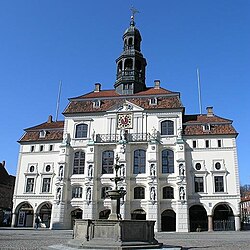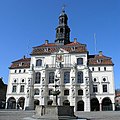Lüneburg
Lüneburg | |
|---|---|
 Lüneburg Town Hall | |
| Coordinates: 53°15′9″N 10°24′52″E / 53.25250°N 10.41444°E | |
| Country | Germany |
| State | Lower Saxony |
| District | Lüneburg |
| Subdivisions | 14 districts |
| Government | |
| • Lord mayor | Ulrich Mädge (SPD) |
| Area | |
| • Total | 70.34 km2 (27.16 sq mi) |
| Elevation | 17 m (56 ft) |
| Population (2022-12-31)[1] | |
| • Total | 76,837 |
| • Density | 1,100/km2 (2,800/sq mi) |
| Time zone | UTC+01:00 (CET) |
| • Summer (DST) | UTC+02:00 (CEST) |
| Postal codes | 21335–21337–21339 |
| Dialling codes | 04131 |
| Vehicle registration | LG |
| Website | www |
Lüneburg is a city in Lower Saxony in north Germany. It is about 50 km southeast of Hamburg. It is the capital of the District of Lüneburg. About 102,660 people live there.
The Ilmenau River, a tributary of the Elbe, flows through Lüneburg.
In the Middle Ages, it was Principality and the town was very rich due to the salt trade. Salt used to be transported along the Old Salt Route to the Baltic Sea from where it was sent by ship to other countries. There were salt mines near the town for a thousand years. Salt mining stopped in 1980. The salt mining caused a lot of deforestation. The countryside changed into heathland which is called the Lüneburger Heide (Lüneburg Heath).
On May 23, 1945, the Nazi war criminal Heinrich Himmler committed suicide in Lüneburg after he had been captured by the British Army. He swallowed a potassium cyanide capsule before his interrogation could begin.
Lüneburg is twinned with Scunthorpe, England.
-
Am Sande
-
Old crane and old store at the medieval Lüneburg harbour
-
Town hall
-
Old harbour
References
[change | change source]Other websites
[change | change source]![]() Media related to Lüneburg at Wikimedia Commons
Media related to Lüneburg at Wikimedia Commons








